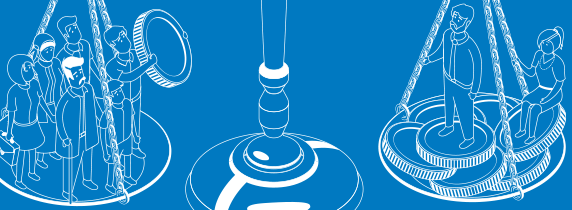Introduction
This is the first time that a Transition Report has focused on economic inequality and inclusion. The thinking on transition has evolved significantly since the first Transition Report was published back in 1994. Initially, much of the emphasis was on the extent and structure of markets and policies that fostered price and trade liberalisation, privatisation, macroeconomic stability, competition and the development of the financial sector. It was clear that market economies outperformed planned economies and that, even if the path towards capitalism involved short-term pain, this was a price worth paying.
Transition for all: Equal opportunities in an unequal world
This is the first time that a Transition Report has focused on economic inequality and inclusion. The thinking on transition has evolved significantly since the first Transition Report was published back in 1994. Initially, much of the emphasis was on the extent and structure of markets and policies that fostered price and trade liberalisation, privatisation, macroeconomic stability, competition and the development of the financial sector. It was clear that market economies outperformed planned economies and that, even if the path towards capitalism involved short-term pain, this was a price worth paying.
In some countries, those reforms were indeed rapid and successful. They managed to create market economies and democratic political systems, and economic growth resumed after only a brief decline in income. Other countries suffered deep and protracted recessions that delayed further reforms – and in some cases, initial reforms were even reversed.
The Transition Report 2013, entitled “Stuck in Transition?”, studied these experiences and identified important patterns. It established that countries which managed to ensure that the benefits of reforms were shared widely across society retained democratic political institutions and continued on a pro-market path. In sharp contrast, countries where the majority of people perceived reforms to be designed for somebody else’s gain saw the reversal of both political and economic transition. In these countries, anti-reform populists took over and built institutions of crony capitalism. Although the initial “short-term pain, long-term gain” logic was correct, these opportunistic politicians managed – by dismantling political checks and balances and suppressing freedom of speech and civil society – to prevent pro-reform parties from challenging them in fair elections.
Thus, even if reforms are beneficial in the long run, they still may not succeed. The benefits of reforms may not materialise if economic gains are not delivered to the majority of the population straight away. What is more, this applies far beyond the EBRD’s countries of operations. Indeed, today many developed countries are also struggling with the appeal of populist politicians. While nativists and Eurosceptics offer no constructive solutions, they do highlight an important problem. Namely, although globalisation and technological progress have delivered great benefits for developed and developing countries on average, they have also resulted in “job polarisation”. In rich countries, automation and globalisation have benefited highly skilled professionals. The industries in which those professionals work have enjoyed access to cheaper inputs and exploited economies of scale in selling their products and services to global markets. Income growth has also created low-skilled jobs – in sectors where jobs could not be automated or outsourced to other countries.
At the same time, many middle-skilled jobs have been either outsourced or automated. The former holders of those jobs have either left the labour force entirely or moved down the skills pyramid – thus enduring reduced pay and further depressing the wages of low-skilled workers. Through this mechanism, globalisation and technological progress have hollowed out the career opportunities of a substantial percentage of the middle class in OECD countries.
Post-communist transition economies have not suffered from job polarisation. In those countries, globalisation has created – not destroyed – high-value-added jobs in exporting sectors. However, as this Transition Report shows, those countries have also suffered from rising inequality and a lack of inclusion. In many countries, inequality rose substantially at the start of transition. The experience of such transition countries has shown that reform processes can get stuck, or even go into reverse, in the absence of sufficient inclusion. If mainstream politicians want to withstand the challenge presented by opportunistic populists, they need to design reforms that do more than just deliver growth on average in the long run. Reformers need to ensure that they enjoy the support of the majority at all times.
Indeed, a well-functioning market economy should be more than just competitive; it should also be inclusive, well-governed, environmentally friendly, resilient and integrated. This is necessary in order to ensure that reforms are politically sustainable: reforms should deliver benefits to the majority of the population in both the short and the long term, preventing populism both in times of crisis and in normal times.
The evaluation of progress in these areas requires new measurement tools. This is why the EBRD has, since 2006, complemented its Business Enterprise Environment and Performance Survey (BEEPS – a survey of business executives) and its Banking Environment and Performance Survey (BEPS – a survey of bank managers) with the Life in Transition Survey (LiTS – a survey of households). In late 2015 and the first half of 2016, the EBRD carried out the third round of the Life in Transition Survey in cooperation with the World Bank, surveying more than 51,000 households in 34 countries (29 post-communist countries, plus Cyprus, Germany, Greece, Italy and Turkey). The analysis of these LiTS data lies at the heart of this year’s Transition Report, allowing us to look beyond average GDP per capita figures and investigate the precise details of individual transition experiences. The report’s four chapters focus on the key aspects of inclusion: the distribution of income and wealth; the impact that the transition from planned to market economies has had on people’s well-being; equality of opportunity; and financial inclusion. The report identifies large sections of society that have suffered – rather than benefited – as a result of pro-market reforms and are excluded from the opportunities that a market economy offers.
Inequality of opportunity is especially important in this regard, since it is ultimately the root of all inequality. Chapter 3 shows that there are no countries with high levels of inequality of opportunity but low levels of inequality of income. Inequality of opportunity is inefficient, as it means that talented individuals cannot achieve their full potential. Also – and most importantly – inequality of opportunity is unfair, and it is regarded as such by the majority of people. Consequently, economic reforms that increase inequality of opportunity are not sustainable in the longer term.
Inequality of opportunity at birth does not necessarily have to result in inequality of outcomes (such as income or wealth inequality). Redistribution of income (through inheritance taxes or wealth taxes, for instance), equal access to education and health care, and geographical mobility all reduce income and wealth inequality for the next generation, even if the previous generation faced high levels of inequality of opportunity. And that decline in inequality of income and wealth then reduces inequality of opportunity for the generation after that. This is why Chapter 1’s analysis of the evolution of inequality over the last 25 years is so important. Unfortunately, that analysis shows that levels of inequality have risen dramatically in most post-communist countries. In many of those countries, economic growth has mostly benefited the rich minority (in some cases, just the top 10 or 20 per cent of households), while the middle class and the poor have lagged behind in terms of income growth. In the EBRD’s newer countries of operations, however, the picture is very different. In those countries, growth has been far more inclusive. In Turkey, for example, it is the middle 80 per cent who have benefited the most from the last 25 years of economic growth.
Chapter 2 shows that the transition experience has indeed been highly traumatic – especially the early years. It shows that people born around the beginning of the transition process have grown up to be an average of around 1 cm shorter than their older and younger peers, indicating that the early years of reforms were a period of substantial socioeconomic deprivation. Interestingly, this pain has eventually been overcome, with the result that these people are now actually happier than their younger and older counterparts in other countries. This is attributable to the increased access to education that has been brought about by the transition process. Education also features prominently in the analysis in Chapter 3, which shows that inequality of opportunity is still higher in post-communist transition countries than it is in western Europe – and that much of the inequality of opportunity seen in those countries is due to parents’ level of education.
Chapter 4 looks at inequality in access to financial services. Financial inclusion remains a major challenge in many countries where the EBRD invests – especially the poorer ones, where substantial gender gaps persist in terms of access to finance. In richer EBRD countries of operations, gender gaps continue to be observed for older generations, but they have been eliminated for younger people.
While this analysis of inequality in the EBRD region results in many worrying findings, there are also a number of reasons for optimism. Chapter 2 shows that the notorious “transition happiness gap” has finally been closed. In the past, residents of post-communist countries used to report significantly lower levels of life satisfaction than their counterparts in non-transition countries with similar income levels. Academics argued that the transition happiness gap was driven by the dramatic events of the early years of the transition process, so the negative impact on subjective well-being should be temporary, rather than permanent. This prediction has finally come true, with residents of post-communist countries now expressing just as much satisfaction with their lives as their peers in other countries.
Although this Transition Report focuses on distributional aspects of the transition process and looks beyond growth in average income, this does not mean that the EBRD believes inclusion to be a substitute for growth. A successful market economy must have both. Without inclusion, pro-growth reforms are not politically sustainable. Without growth, however, inclusion policies become a zero-sum game – redistributing the pie, rather than growing it – and therefore result in conflict. Thus, growth remains at the heart of the EBRD’s work and will be studied in detail in future Transition Reports.

Sergei Guriev
Chief Economist, EBRD
About
The EBRD seeks to foster the transition to an open market-oriented economy and to promote entrepreneurship in its countries of operations. To perform this task effectively, the Bank needs to analyse and understand the process of transition. The purpose of the Transition Report is to advance this understanding and to share our analysis with partners.
The responsibility for the content of the report is taken by the Office of the Chief Economist. The assessments and views expressed are not necessarily those of the EBRD. All assessments and data are based on information as of late October 2016.
Highlights
The EBRD is investing in changing people’s lives and environments across a region that stretches from central Europe to Central Asia, the Western Balkans and the southern and eastern Mediterranean.












